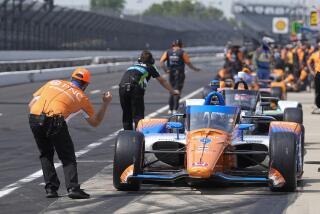IRL to Reduce Engine RPMs Again
- Share via
INDIANAPOLIS — Indy Racing League cars will slow down after the 500, and not just because the race is over.
Leo Mehl, IRL executive director, announced Thursday that, starting with the race June 12 at Texas Motor Speedway, engine RPMs will be reduced from 10,300 to 10,000 for the rest of the season. The resultant loss of 20-30 horsepower from more than 700 will mean a slight reduction in speeds.
The change is the second such this season--RPMs were reduced from 10,500 last season to 10,300 at season’s start--and was made for two reasons, Mehl said, increased safety and increased competition.
The safety concerns were triggered by the accident in which three spectators were killed by a flying wheel and other debris during an IRL race May 1 at Lowe’s Motor Speedway in Concord, N.C., formerly the Charlotte Speedway.
“We need to show . . . that we’re responding to the tragedy at Charlotte,” Mehl said.
Earlier this week, the IRL announced that a wheel-tether system would be in place for Sunday’s Indy 500, another change prompted by the Charlotte accident.
The competition angle?
Said Phil Casey, IRL technical director, “[Mechanics] found about 20 horsepower in the engines this year and that caught us a little by surprise.”
Expanding on that, Mehl said, “The simple fact is, if you reduce the RPMs, you slow the cars down and make the drivers more comfortable. You can’t race at 240 mph. The drivers always say they want more speed and that they’ll race side by side at 240 but they don’t.”
RPMs are controlled electronically by preset “rev limiters” that cannot be manipulated by race teams.
The IRL, which was formed before the 1996 Indy 500, went to normally aspirated stock block engines a year later, switching from the turbocharged racing engines used in rival CART cars. Since then, speeds here have been in the low to middle 220s. Pole sitter Arie Luyendyk, who set the track record of 237.498 in a CART car in ‘96, qualified for this year’s race at 225.179.
*
Luyendyk’s teammate, Sam Schmidt, who qualified seventh last weekend, was the fastest driver on carburetion day, the last practice for Sunday’s race.
Schmidt, driving a G Force-Aurora, turned a fast lap of 222.458 mph, nearly as fast as his 222.734 qualifying speed. Carb day speeds normally are considerably slower than qualifying speeds because drivers are more concerned with race setups and running with full fuel tanks.
Greg Ray was next fastest, in two cars. He drove his own Dallara-Aurora at 221.822, then drove teammate Robby Gordon’s at 221.790. Gordon was in Madison, Ill., across the Mississippi River from St. Louis, practicing for CART’s 300-mile race Saturday.
More to Read
Go beyond the scoreboard
Get the latest on L.A.'s teams in the daily Sports Report newsletter.
You may occasionally receive promotional content from the Los Angeles Times.










